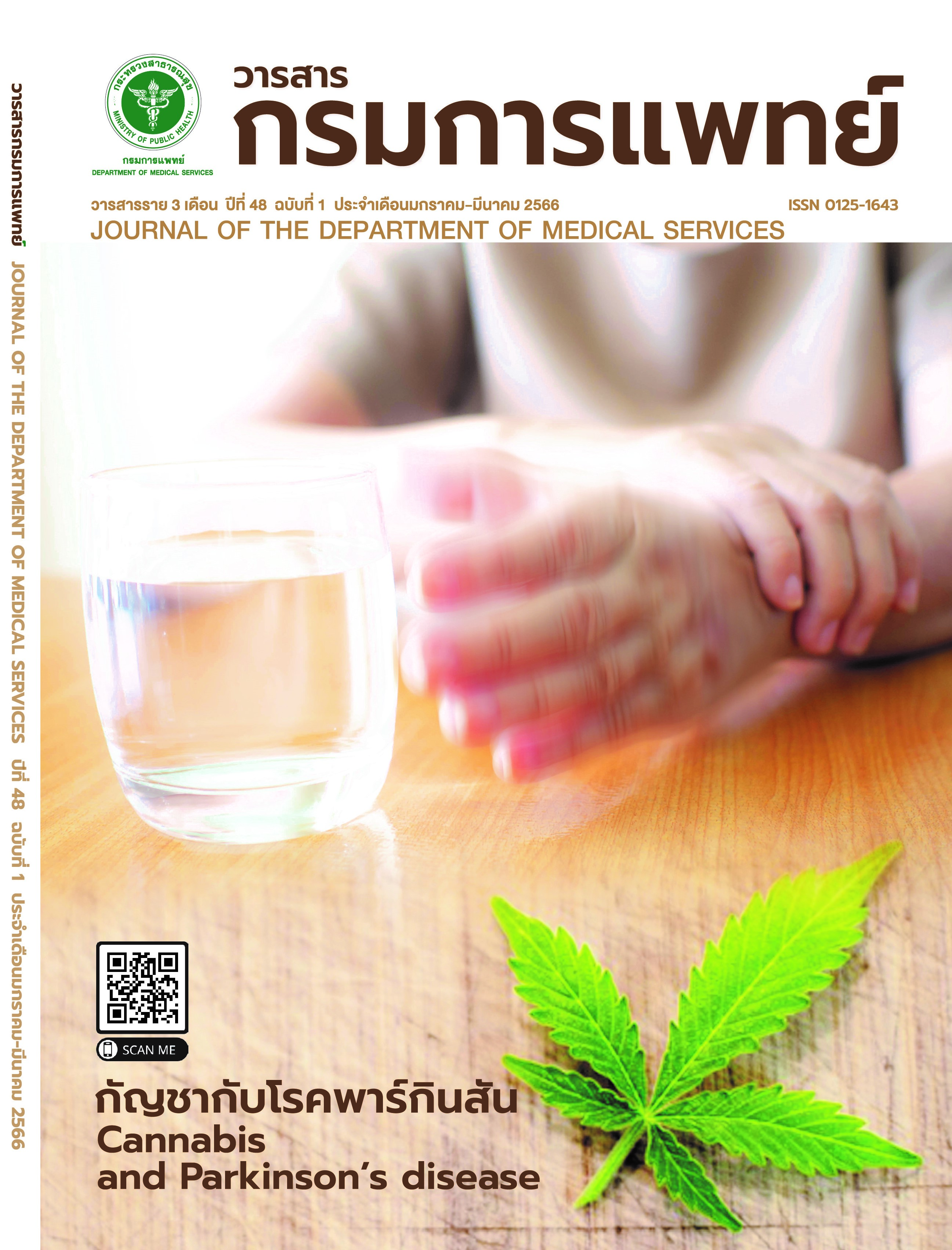Clinical Outcome of Bacteremic Melioidosis: A five-year Retrospective Study
Keywords:
Bacteremic melioidosis, Clinical outcome, MortalityAbstract
Background: Melioidosis is an infectious disease caused by Burkholderia pseudomallei. It is a disease of public health importance in Thailand and is associated with high fatality rates. Objective: to evaluate clinical outcomes, characteristics, and factors influencing mortality of the patients with bacteremic melioidosis in Songkhla Hospital. Method: A retrospective cohort study of all patients (≥15 years old) admitted to the hospital from January 2015 to December 2019 with positive blood cultures for B. pseudomallei was conducted. Result: A total of 81 hemoculture-confirmed B. pseudomallei during the study period. The ages of the patients ranged from 22 to 82 years old, with a mean of 53.27 ± 14.51 years old. At least one underlying disease was documented in 68 (84%) of the patients. Most patients (50 patients, 61.7%) were referred from community hospitals. The common site of infection was a pulmonary infection, which was found in 38% of the patients, disseminated infection in 17.3%, and bacteremia without a documented site of infection was found in 37%. The median (IQR) SOFA score was 4 (0, 9) points. The overall unfavorable outcome was found in 35 patients (43.2%), including in-hospital mortality of 26 patients (32.1%), together with withdrawal treatment for end-of-life care at home for 9 patients (11.1%). Four different factors were found to have significantly influenced the unfavorable outcomes in univariate analysis, including septic shock (68.6% VS 28.3%, p < .001), acute respiratory failure (80% VS 34.8%, p < .001), DIC (20% VS 4.3%, p = .026), and high SOFA score (8 VS 1.5, p < .001). However, none of the comparisons was significant in multivariate analysis. Conclusions: Bacteremic melioidosis has a high mortality rate, and most of the unfavorable outcomes occurred within 72 hours after presentation to the hospital. Patients with septic shock, acute respiratory failure, DIC, and high SOFA scores have significantly higher mortality in univariate analysis.
References
Chakravorty A, Heath CH. Melioidosis: An updated review. AustJ Gen Pract. 2019; 48:327-332.
Currie BJ, Ward L, Cheng AC. The epidemiology and clinicalspectrum of melioidosis: 540 cases from the 20 year Darwinprospective study. PLoS Negl Trop Dis. 2010; 4
Dance D. Treatment and prophylaxis of melioidosis. Int JAntimicrob Agents. 2014; 43:310-8
Churuangsuk C, Chusri S, Hortiwakul T, Charernmak B,Silpapojakul K. Characteristics, clinical outcomes and factorsinfluencing mortality of patients with melioidosis in southernThailand: A 10-year retrospective study. Asian Pac J Trop Med.2016; 9: 256-60.
Jatapai A, Gregory CJ, Thamthitiwat S, Tanwisaid K, Bhengsri S,Baggett HC, et al. Hospitalized Bacteremic Melioidosis in RuralThailand: 2009-2013. Am J Trop Med Hyg. 2018; 98:1585-91.
Simpson AJ, Suputtamongkol Y, Smith MD, Angus BJ,Rajanuwong A, Wuthiekanun V, et al. Comparison of imipenemand ceftazidime as therapy for severe melioidosis. Clin InfectDis. 1999; 29:381-7.
Van Heuverswyn J, Valik JK, van der Werff SD, Hedberg P, Giske C,Nauclér P. Association between time to appropriate antimicrobialtreatment and 30-day mortality in patients with bloodstreaminfections: a retrospective cohort study. Clin Infect Dis. 2022
Lee CC, Lee CH, Hong MY, Tang HJ, Ko WC. Timing of appropriateempirical antimicrobial administration and outcome of adultswith community-onset bacteremia. Crit Care. 2017; 21:119.
Evans L, Rhodes A, Alhazzani W, Antonelli M, CoopersmithCM, French C, et al. Surviving sepsis campaign: internationalguidelines for management of sepsis and septic shock 2021.Intensive Care Med. 2021; 47:1181-1247.
Downloads
Published
How to Cite
Issue
Section
License
Copyright (c) 2023 Department of Medical Services, Ministry of Public Health

This work is licensed under a Creative Commons Attribution-NonCommercial-NoDerivatives 4.0 International License.
บทความที่ได้รับการตีพิมพ์เป็นลิขสิทธิ์ของกรมการแพทย์ กระทรวงสาธารณสุข
ข้อความและข้อคิดเห็นต่างๆ เป็นของผู้เขียนบทความ ไม่ใช่ความเห็นของกองบรรณาธิการหรือของวารสารกรมการแพทย์



